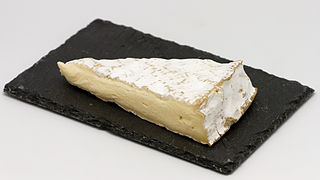
Brie is a soft cow's-milk cheese named after Brie, the French region from which it originated. It is pale in color with a slight grayish tinge under a rind of white mould. The rind is typically eaten, with its flavor depending largely upon the ingredients used and its manufacturing environment. It is similar to Camembert, which is native to a different region of France. Brie typically contains between 60% and 75% butterfat, slightly higher than Camembert.

Parmesan is an Italian hard, granular cheese produced from cows' milk and aged at least 12 months.

Goat cheese, goat's cheese, or chèvre is cheese made from goat's milk. Goats were among the first animals to be domesticated for producing food. Goat cheese is made around the world with a variety of recipes, giving many different styles of cheeses, from fresh and soft to aged and hard.
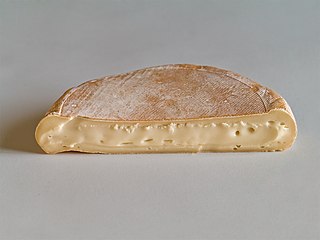
Reblochon is a soft washed-rind and smear-ripened French cheese made in the Alpine region of Haute-Savoie from raw cow's milk. It has its own AOC designation.

Beaufort is a firm, raw cow's milk cheese associated with the gruyère family. An Alpine cheese, it is produced in Beaufortain, Tarentaise valley and Maurienne, which are located in the Savoie region of the French Alps.

Fontina is a cow's milk cheese, first produced in Italy. Over time, production of Fontina has spread worldwide, including to the United States, Denmark, Sweden, Canada, France and Argentina.

Rocamadour is a French cheese from the southwest part of the country. It is produced in the regions of Périgord and Quercy and takes its name from the village of Rocamadour in the département of the Lot.
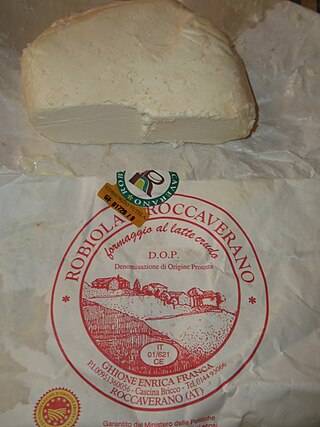
Robiola is an Italian soft-ripened cheese of the Stracchino family. It is from the Langhe region and made with varying proportions of cow's, goat's, and sheep's milk. One theory is that the cheese gets its name from the town of Robbio in the province of Pavia; another that the name comes from the word rubeole (ruddy) because of the color of the seasoned rind.
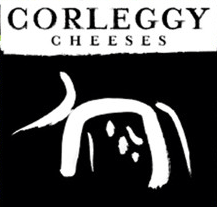
Corleggy Cheeses is an Irish cheese producer in County Cavan. It was started by Silke Cropp in 1985 using milk from her own goat herd. Today Corleggy make a variety of different cheese from goat's milk, sheep's milk and cow's milk sourced from local farmers.

Val Brembana is a valley in Lombardy, Northern Italy. It takes its name from the river flowing in it, the Brembo.

Caprino is an Italian cheese traditionally made from whole or skimmed goat's milk. The name of the cheese derives from the Italian word for goat, capra. With modern methods of production, the cheese is made from cow's milk as well or a combination of both cow's and goat's milks. The two major styles of caprino are fresco ("fresh") and stagionato ("aged").
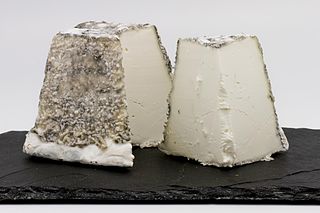
There are many different types of cheese. Cheeses can be grouped or classified according to criteria such as length of fermentation, texture, methods of production, fat content, animal milk, and country or region of origin. The method most commonly and traditionally used is based on moisture content, which is then further narrowed down by fat content and curing or ripening methods. The criteria may either be used singly or in combination, with no single method being universally used.

Raschera is an Italian pressed fat or medium fat, semi-hard cheese made with raw or pasteurized cow milk, to which a small amount of sheep's and/or goat's milk may be added. It has an ivory white color inside with irregularly spaced small eyes, and a semi-hard rind which is red gray sometimes with yellow highlights. It has a savory and salty taste, similar to Muenster cheese, and can be moderately sharp if the cheese has been aged.
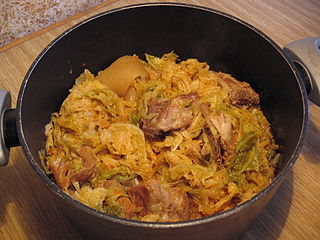
Lombard cuisine is the style of cooking in the Northern Italian region of Lombardy. The historical events of its provinces and of the diversity of its territories resulted in a varied culinary tradition. First courses in Lombard cuisine range from risottos to soups and stuffed pasta, and a large choice of second course meat or fish dishes, due to the many lakes and rivers of Lombardy.

Bitto is an Italian DOP cheese produced in the Valtelline Valley, in Lombardy. It owes its name to the Bitto River. Bitto is produced only in the summer months, when the cows feed on the high alpine meadows.

Puzzone di Moena, is an Italian PDO cheese, with a washed rind, fat and semi-hard pressed paste made from raw cow's milk.
















